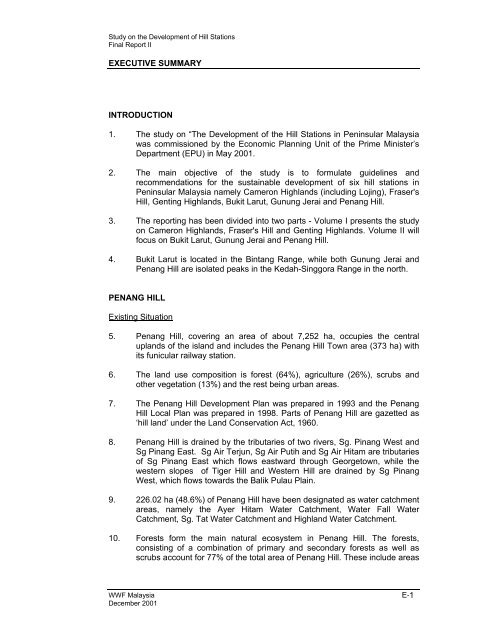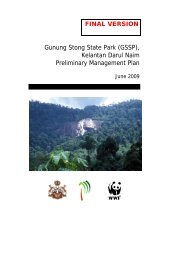WWFM_Hill Stations Study Vol2_2001.pdf - Sdn Bhd - WWF Malaysia
WWFM_Hill Stations Study Vol2_2001.pdf - Sdn Bhd - WWF Malaysia
WWFM_Hill Stations Study Vol2_2001.pdf - Sdn Bhd - WWF Malaysia
You also want an ePaper? Increase the reach of your titles
YUMPU automatically turns print PDFs into web optimized ePapers that Google loves.
<strong>Study</strong> on the Development of <strong>Hill</strong> <strong>Stations</strong><br />
Final Report II<br />
EXECUTIVE SUMMARY<br />
INTRODUCTION<br />
1. The study on “The Development of the <strong>Hill</strong> <strong>Stations</strong> in Peninsular <strong>Malaysia</strong><br />
was commissioned by the Economic Planning Unit of the Prime Minister’s<br />
Department (EPU) in May 2001.<br />
2. The main objective of the study is to formulate guidelines and<br />
recommendations for the sustainable development of six hill stations in<br />
Peninsular <strong>Malaysia</strong> namely Cameron Highlands (including Lojing), Fraser's<br />
<strong>Hill</strong>, Genting Highlands, Bukit Larut, Gunung Jerai and Penang <strong>Hill</strong>.<br />
3. The reporting has been divided into two parts - Volume I presents the study<br />
on Cameron Highlands, Fraser's <strong>Hill</strong> and Genting Highlands. Volume II will<br />
focus on Bukit Larut, Gunung Jerai and Penang <strong>Hill</strong>.<br />
4. Bukit Larut is located in the Bintang Range, while both Gunung Jerai and<br />
Penang <strong>Hill</strong> are isolated peaks in the Kedah-Singgora Range in the north.<br />
PENANG HILL<br />
Existing Situation<br />
5. Penang <strong>Hill</strong>, covering an area of about 7,252 ha, occupies the central<br />
uplands of the island and includes the Penang <strong>Hill</strong> Town area (373 ha) with<br />
its funicular railway station.<br />
6. The land use composition is forest (64%), agriculture (26%), scrubs and<br />
other vegetation (13%) and the rest being urban areas.<br />
7. The Penang <strong>Hill</strong> Development Plan was prepared in 1993 and the Penang<br />
<strong>Hill</strong> Local Plan was prepared in 1998. Parts of Penang <strong>Hill</strong> are gazetted as<br />
‘hill land’ under the Land Conservation Act, 1960.<br />
8. Penang <strong>Hill</strong> is drained by the tributaries of two rivers, Sg. Pinang West and<br />
Sg Pinang East. Sg Air Terjun, Sg Air Putih and Sg Air Hitam are tributaries<br />
of Sg Pinang East which flows eastward through Georgetown, while the<br />
western slopes of Tiger <strong>Hill</strong> and Western <strong>Hill</strong> are drained by Sg Pinang<br />
West, which flows towards the Balik Pulau Plain.<br />
9. 226.02 ha (48.6%) of Penang <strong>Hill</strong> have been designated as water catchment<br />
areas, namely the Ayer Hitam Water Catchment, Water Fall Water<br />
Catchment, Sg. Tat Water Catchment and Highland Water Catchment.<br />
10. Forests form the main natural ecosystem in Penang <strong>Hill</strong>. The forests,<br />
consisting of a combination of primary and secondary forests as well as<br />
scrubs account for 77% of the total area of Penang <strong>Hill</strong>. These include areas<br />
<strong>WWF</strong> <strong>Malaysia</strong> E- 1<br />
December 2001
















